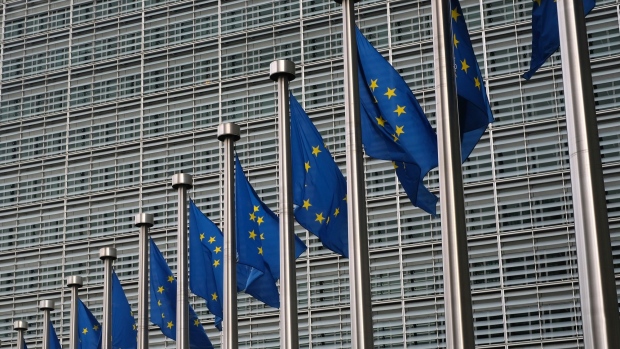Sep 14, 2022
Asset Managers Are Facing Hundreds of ESG Fund Downgrades
, Bloomberg News

(Bloomberg) -- Asset managers across Europe may have to reclassify hundreds of ESG funds in the coming months.
Reviews by researchers including Morningstar Inc. show that only a small fraction of funds registered as Article 9 -- the EU’s strictest ESG category -- actually lives up to the level of sustainable investments required under European rules.
Lawyers advising the industry are now warning that many fund managers may have little choice but to change their official ESG designations. The upshot is that clients who thought they’d signed up for the EU’s cleanest ESG product suddenly are left with something else.
“I can imagine there being lots of reclassifications from Article 9” to a less strict ESG designation known as Article 8, said Rahul Manvatkar, an investment funds partner at Linklaters in London. “As much as they may not want to, that’s probably the trajectory as market participants get to grips with the rules.”
A number of prominent asset managers have already resorted to downgrades following guidance from the EU. These include Pacific Investment Management Co., which reclassified four funds to Article 8 from 9, and Goldman Sachs Group Inc.’s NN Investment Partners, which downgraded 10 funds.
Read More: Pimco, NN Investment Downgrade ESG Funds Amid Rule Confusion
Europe enforced the world’s most ambitious rulebook for environmental, social and governance investing in March 2021. But the full scale of the challenges posed by that framework -- the Sustainable Finance Disclosure Regulation -- is only now becoming apparent.
Fund managers say they don’t have anywhere near enough data to comply, and SFDR is continually being fine-tuned as rulemakers acknowledge gaps. The EU Commission has said that an Article 9 fund “may invest in a wide range” of assets “provided these underlying assets qualify as sustainable investments,” while allowing for liquidity and hedging needs.
In other words, EU authorities have “made it clear that Article 9 funds should commit to invest almost exclusively in sustainable investments,” said Hugo Gallagher, senior policy adviser at the European Sustainable Investment Forum (Eurosif), whose members represent about $20 trillion in assets under management.
“Clearly, a significant proportion of funds classified as Article 9 are far short of meeting this threshold,” he said.
Morningstar estimates that Article 9 funds currently represent about 470 billion euros ($470 billion) of assets under management. Article 9 funds worth 25 billion euros have already been downgraded in the past six months, according to an estimate by Barclays Plc analysts led by Charlotte Edwards that’s based on Morningstar data.
More than 300 Article 9 funds have reported a minimum threshold in sustainable investments that is less than 90%, putting them at risk of losing their designation, data provider FE fundinfo told Bloomberg. Many more failed to provide any indication of their sustainability targets, suggesting the figure may be meaningfully higher than 300.
The Articles...
SFDR requires firms to classify their investment products under one of three categories: Article 6, which only looks at potential ESG risks; Article 8, which is supposed to “promote” ESG characteristics; and Article 9, which sets measurable ESG “objectives.”
Regulators are also struggling to interpret the rules. The EU’s three financial supervisory authorities have asked the European Commission for more guidance on several fundamental issues around how to define a sustainable investment. Meanwhile, national authorities are left to patrol the industry, with the European Securities and Markets Authority saying it will intervene if necessary.
Morningstar, which estimates that there are roughly 950 Article 9 funds in total, said that about 40% of these have a sustainable investment goal that is less than 50%. Just 2.5% target allocations higher than 90% and only a dozen report 100% sustainable investments.
“This begs the question: Was it really what the regulator intended? Probably not,” said Hortense Bioy, global director of sustainable research at Morningstar.
Either way, “the end result for asset managers will be to either reclassify funds from Article 9 to Article 8, or enhance their Article 9 strategies by tightening up their investment criteria,” she said.
Concern about the credibility of Article 9 designations follows significant flows into the fund category. Investors poured about $6 billion into such funds during the second quarter and withdrew more than $30 billion from the weaker Article 8 designation, Morningstar reported.
Bioy said that some fund managers eager to hold on to their Article 9 designations will now try “working backwards,” whereby they look for a methodology that offers a path to meeting EU requirements.
“The reality is even that won’t work for most Article 9 funds,” she said. “So the regulator may need to provide further clarification.”
Gallagher at Eurosif said that even if more Article 9 fund managers were claiming to meet the EU’s sustainability criteria, holes in the way sustainability is defined mean clients would ultimately have limited insight. He said higher fund targets might actually disguise weaker definitions of sustainability.
Behind the scenes, fund managers say EU officials are guiding the industry to have no less than 80% sustainable assets in Article 9 funds.
So setting a threshold below that level is highly risky, according to Eric Pedersen, head of responsible investment at Nordea Asset Management. “How could you think that would pass muster?”
And if a fund with less than 60% sustainable assets tries to call itself Article 9, “then that’s very strange,” he said. “It would be greenwashing where you were almost guaranteed to get caught.”
Matthias Breier, ESG product manager at FE fundinfo, said he expects regulators will soon weigh in.
As funds start to “inform the market they aren’t 100% aligned with sustainable metrics, then we would expect the local authorities to reach out and tell them you cannot have an Article 9 fund,” he said.
(Adds estimate of downgrades so far in 10th paragraph)
©2022 Bloomberg L.P.





